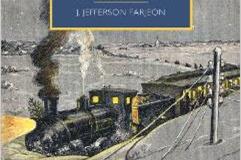 In a year of unsettling cultural stories—from the Ray Rice domestic abuse video to Robin Williams’s suicide to the Slender Man stabbing to terrorism threats forcing the recall of a comedy movie depicting the assassination of dictator Kim Jong Un—one of the most unlikely is, uncharacteristically, entirely good news, as the (UK) Independent reports:
In a year of unsettling cultural stories—from the Ray Rice domestic abuse video to Robin Williams’s suicide to the Slender Man stabbing to terrorism threats forcing the recall of a comedy movie depicting the assassination of dictator Kim Jong Un—one of the most unlikely is, uncharacteristically, entirely good news, as the (UK) Independent reports:
In a development that no one expected, Mystery in White: A Christmas Crime Story has already sold more than 60,000 copies, and the UK and U.S. distributors even ran out of copies at times (although the e-book version has, of course, remained available). That is a truly impressive sales number, eclipsing, as noted earlier, many very popular contemporary books of fiction.
I have not yet read Farjeon’s novel, but several friends and acquaintances have, and all have praised it (for examples, British crime writer Martin Edwards, who wrote the introduction to the current re-release, and American crime fiction historian and blogger Les Blatt).
First published way back in 1937, Mystery in White is basically a country house mystery, a type of narrative that is very much out of fashion these days. A group of train travellers stranded by a snowstorm take refuge in an abandoned house which appears, unaccountably, to have been made ready for a cozy teatime gathering. Murder intervenes, of course, and there are goodly helpings of both suspense and humor, all in the course of a relatively concise and coherent story rather shorter than the typical expansive crime novel of our time.
That is to say, it is a truly old-fashioned mystery, very much of its time. Despite the desperately bad economic times and the rapid decline into a second world war, the culture of the 1930s manifested significantly more optimism than our culture has in the past couple of decades. That sense of optimism and often explicit “can do” attitude is something that may be especially precious today for its relative scarcity.
A representative of one of the major British booksellers affirmed that notion, the Independent reports:
Joseph Knobbs, Waterstones’ crime fiction buyer, said he thought the sales could reflect readers yearning for genuine mysteries rather than darker, modern thrillers: “Mystery in White has been our bestselling paperback this Christmas and one of the most pleasant surprises of the year.
“The Crime Classics stand out against the darker crop of contemporary crime fiction and offer something a bit different. A lot of modern stuff skews closer to thriller than mystery. It has been a treat to see mystery writers such as John Bude, Mavis Doriel Hay and J Jefferson Farjeon get their due. I think that’s a credit to the British Library, which has not only done the important work of archiving this material, but now brought it to a wider audience,” he said.
Certainly such darkness has been the dominant theme and motif of popular fiction, movies, and TV fare in the United States for at least a couple of decades now, and there is clearly a large number of people who are looking for something different.
British Library Publishing began its Crime Classics series with an 1860 novel, The Notting Hill Mystery, which has historical significance but is Victorian in its sensibilities and hence more foreign to modern readers. Sales of the series ramped up significantly, however, this year as the publisher began reprinting mystery novels from the 1930s and ’40s, in which the technologies and life situations are easily recognizable to modern-day readers but which reflect the more optimistic sensibility of the pre-World War II era:
Robert Davies, from British Library Publishing, said: “For years, publishers have been concentrating on dark, violent, psychological crime novels, but we spotted a gap in the market for readers seeking escapist detective fiction with superb plots and period atmosphere.
As I noted above, there has indeed been “a gap in the market” for readers, movie audiences, and TV viewers seeking a more intellectual and less pessimistic type of entertainment, and the sales of this obscure mystery suggest that consumers will go a rather long way in search of it.
To be sure, dystopian book and film series such as The Hunger Games, Divergent, Matched, The Maze Runner, and many others remain highly popular, especially among young people raised in the post-9/11, stagnant-economy decades of the present century. In fact, the current culture has very possibly reached a point where, as Nigel Tufnel said in This Is Spinal Tap, “It’s like, how much more black could this be? and the answer is none. None more black.”
There are good reasons that these things run in cycles. With the culture having gone about as far as it can in this direction, and with variety in short supply, audiences will naturally seek out something new. And when that “something new” is nearly eight decades old, it should be clear that there is a large, untapped market for more positive cultural products. Perhaps the tide is beginning to turn.

